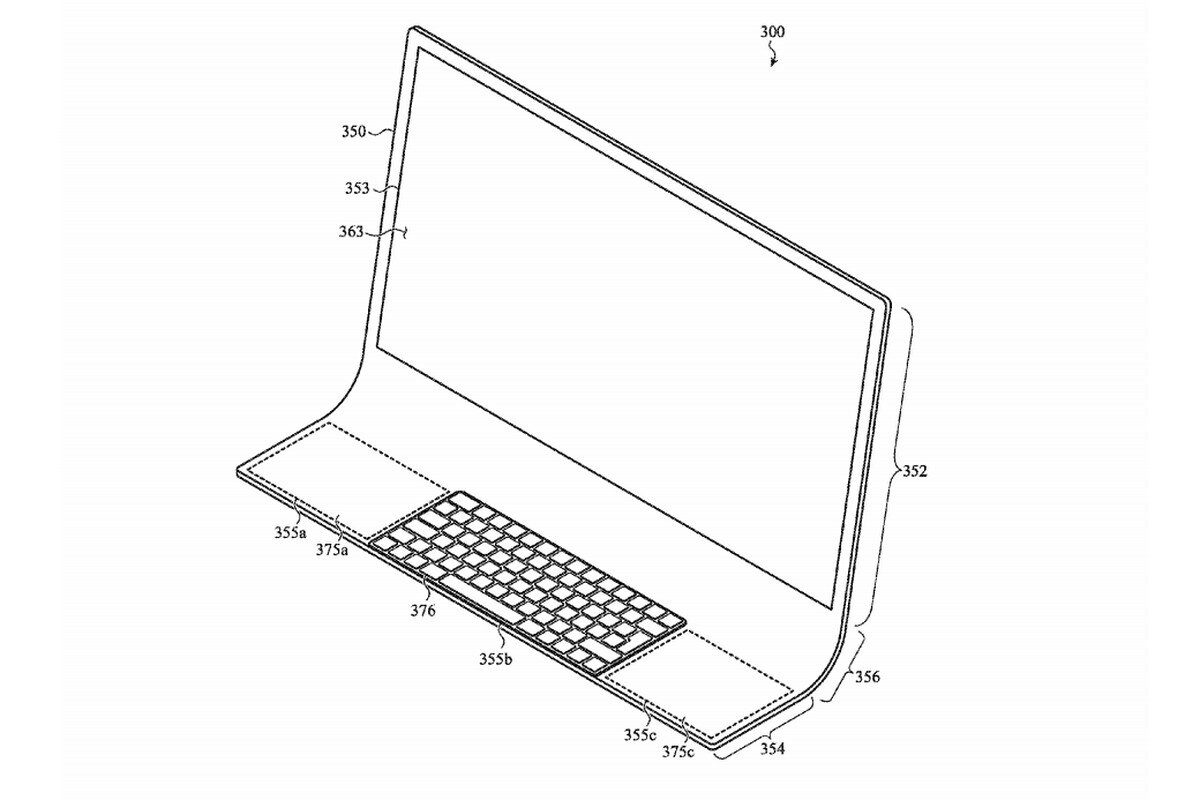
Apple's ideas for future coolth are interesting in light of patent applications with the US Patent and Trademark Office.
As in? A radical desktop computer design that presents a sheet of curved glass.
As in? Haptic-feedback finger devices to control objects in mixed reality and virtual reality.
Apple patent watchers were definitely eager to talk about the sheet of curved glass. Engadget's reaction was typical of most reactions among tech watchers—maybe this will happen, maybe not.
"This isn't a product roadmap for Apple—we wouldn't count on a curved-glass Mac like this arriving soon, if at all," said Engadget. "There would be technical limitations to overcome like adjustability of the display...This patent application does shed light on Apple's design process, though, and suggests that it's willing to dramatically revamp desktop Macs..."
Andrew Griffin, Independent, had a similar conclusion, that Apple's design process appeared to be considering "entirely new kinds of computers."
AppleInsider showed just how visually interesting this idea is: consider an "all-in-one desktop so it effectively exists as a single sheet of curved glass with an embedded display."
Victoria Song in Gizmodo commented: "The patent itself is pretty broadly defined—in some instances, it proposes the trackpad and keyboard are built-in, in others they're separate. Griffin noticed its separate stand at the back, "which presumably would hold the parts of the computer that could not be transparent."
The US Patent and Trademark Office received Apple's patent application for an "Electronic Device with Glass Housing Member," filed in May last year and published on Jan. 23.
The summary portion of the patent application included this:
"An electronic device may include a slumped glass housing member defining a continuous exterior surface of the electronic device and an opening extending through the slumped glass housing member... The electronic device may include a display coupled to an upper portion of the slumped glass housing member. The electronic device may include a keyboard having a storage configuration in which the keyboard is positioned at least partially within the opening and a use configuration in which the keyboard is extended from the opening."

Griffin, meanwhile, noted what was special about the design idea. "Just like the current iMac, the computer exists as one big slab, housing both the display and the components. But unlike any Apple computer ever seen, that is a slab of glass, presumably allowing the computer to sit invisibly until it needs to be used. What's more, the display's curve could move, or it could be folded away entirely, the patent suggests."
While Apple patent watchers were interpreting the patent talk as a vision for the future radical iMac, the patent application said the concept had wider possibilities in material and form factor. All things for all dreamers?
"it should be understood that the following descriptions are not intended to limit the embodiments to one preferred embodiment," according to the patent.
"The housing member may be formed from any suitable material, such as plastic, ceramic, glass, composites, or combinations thereof. For example, the housing member may be a single piece of glass that has been molded (e.g., slumped) to form the various portions of the housing member. The electronic device may take the form of or be included in any suitable computing device, including a desktop computer, a laptop, a tablet, a smartphone, an automobile, a wearable audio device, an appliance, an accessory device, or the like."
As for the desktop glass vision, a reader comment on the Independent article said "This glass design looks like an ergonomic nightmare designed to attract attention, not improve productivity."
Another patent topic starring forward-thinkers at Apple: wearables for virtual reality and mixed reality in the form of devices on the fingers.
The patent application for "Computer Systems With Finger Devices" was published Jan. 23 by the US Patent and Trademark Office. It was filed in April last year.
William Gallagher, AppleInsider, said users would use them to interact with items in a virtual space. "Instead of large gloves that are awkward to wear, or haptic feedback displays that can only provide minimal feedback, Apple proposes slim sensors that can be worn on the finger."
The key to these devices are sensors: force sensors, optical sensors and ultrasonic sensors. CNET said the input could be used to control virtual objects in mixed reality or virtual reality environments.
Patently Apple said the finger devices would work with Apple's MR Headset.
In the Detailed Description portion of the patent application, one gets a better idea of what the finger devices would look like on the user's hand or hands.
"Finger devices can be worn on any or all of a user's fingers (e.g., the index finger, the index finger and thumb, three of a user's fingers on one of the user's hands, some or all fingers on both hands, etc.). To enhance the sensitivity of a user's touch as the user interacts with surrounding objects, finger devices may have inverted U shapes or other configurations that allow the finger devices to be worn over the top and sides of a user's finger tips while leaving the user's finger pads exposed. This allows a user to touch objects with the finger pad portions of the user's fingers during use. If desired, finger devices may be worn over knuckles on a user's finger, between knuckles, and/or on other portions of a user's finger."
© 2020 Science X Network
Citation: Apple patent talk: Sheet of glass computer, finger wearables (2020, January 29) retrieved 29 January 2020 from https://techxplore.com/news/2020-01-apple-patent-sheet-glass-finger.html
This document is subject to copyright. Apart from any fair dealing for the purpose of private study or research, no part may be reproduced without the written permission. The content is provided for information purposes only.
